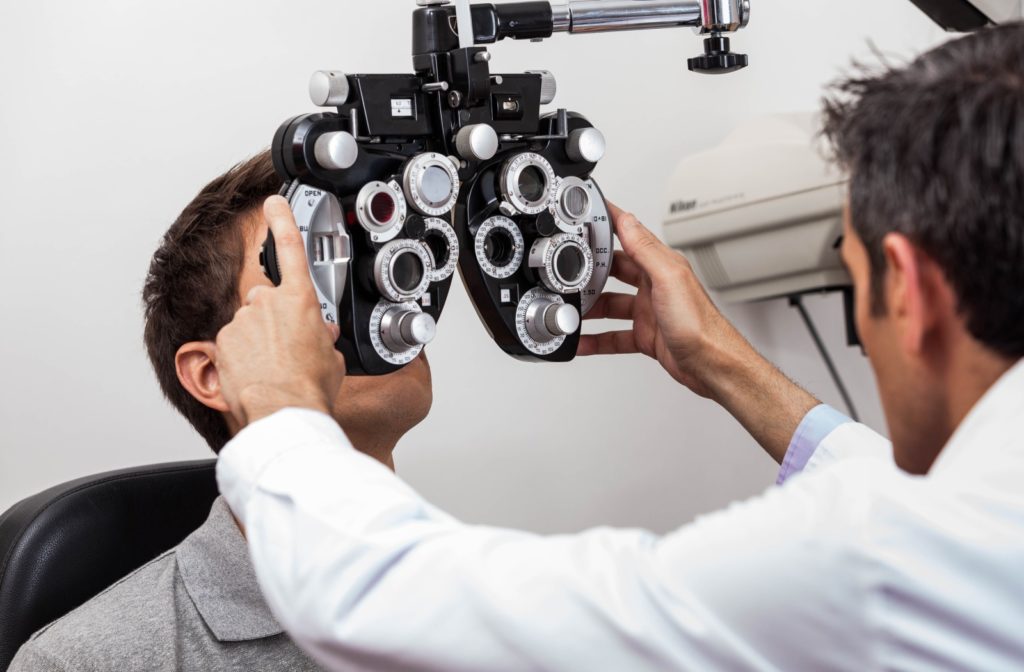Floaters are small spots or thread-like shapes that drift across your field of vision. They are often most noticeable when looking at bright or plain backgrounds, like a clear sky or a white wall. Floaters are a natural phenomenon caused by age. In your 20s, floaters are less common, but they can still occur.
In most cases, floaters are harmless and caused by changes in the gel-like vitreous inside your eye. However, they can sometimes indicate a more serious condition, particularly if they appear suddenly or are accompanied by other symptoms, such as flashes of light.
Routine eye exams are critical for monitoring changes in your vision and your eye health.
What Causes Floaters?
The vitreous humour helps maintain the shape of your eye and allows light to pass through. As you age, it can start to shrink, causing small fibres to break away and float around inside it. These bits cast shadows on your retina, which is what you see as floaters.
While vitreous changes typically occur after age 50, people in their 20s can still experience occasional floaters due to natural shifts in the eye or other factors, such as:
- Natural vitreous changes: Even at a young age, subtle changes in the vitreous can result in occasional floaters.
- Eye injuries: Trauma to the eye can cause floaters to develop as the vitreous shifts or tears.
- Inflammation: Conditions like uveitis, which causes inflammation in the eye, can lead to floaters.
Floaters are often harmless, but any sudden or severe vision changes should be taken seriously. If you notice any concerning symptoms, such as a rapid increase in floaters, flashes of light, or vision loss, schedule an eye exam as soon as possible.
When Are Floaters a Concern?
While floaters are often a natural part of the aging process, a sudden increase in floaters, accompanied by flashes of light or a shadow/curtain-like effect over your vision, may signal a retinal detachment and should be addressed promptly by your eye doctor.
Are Floaters Related to Age or Lifestyle?
Floaters are primarily related to age, but certain lifestyle factors can also play a role in their development, especially in younger individuals. For example:
- Dehydration: Chronic dehydration can affect the health of your eyes and the vitreous, potentially leading to floaters.
- Poor diet: A lack of nutrients like omega-3 fatty acids and antioxidants may impact eye health, though it’s more of a general risk factor for eye problems.
- Near-sightedness (myopia): People who are nearsighted are more likely to experience floaters, as their eyes tend to be longer, causing the vitreous to change more rapidly.
- Eye injuries: Trauma to the eye can lead to floaters if the vitreous shifts or tears.
- Inflammation: Certain eye conditions, like uveitis, can cause inflammation in the eye, which may result in floaters.
Regular eye exams are essential for monitoring your eye health and identifying any concerns.

How Are Floaters Diagnosed?
Your eye care team uses several diagnostic tools to evaluate floaters and determine their cause. During a comprehensive eye exam, your doctor will:
- Check for signs of inflammation, retinal tears, or other abnormalities that could indicate a more serious condition.
- Assess whether floaters are stable or require further monitoring based on their appearance and your symptoms.
Managing Floaters & Maintaining Eye Health
Most floaters are harmless and don’t require treatment, but if they become distracting, you can try a few strategies to minimize their impact:
- Move your eyes: Shifting your gaze up and down or side to side can help floaters move out of your central vision.
- Adjust your lighting: Bright or direct light can make floaters more noticeable. Using softer, indirect lighting may help reduce their visibility.
- Give it time. Many people adjust to floaters over time as their brain learns to ignore them. Floaters will also settle below the line of sight.
In rare cases where floaters significantly interfere with vision, an eye care professional may discuss treatment options:
- Laser vitreolysis: A laser is used to break up large floaters, making them less noticeable.
- Vitrectomy: A surgical procedure that removes the vitreous gel and replaces it with a clear solution, typically reserved for severe cases due to potential risks.
Floaters can’t really be prevented, but regular eye exams help ensure they’re not linked to more serious conditions like retinal tears or detachment.
Comprehensive Care for Floaters in Saskatoon
At Pinehouse Eye Care, we provide expert care to address floaters and other eye concerns. Whether you’re experiencing occasional floaters or sudden changes in your vision, we’re here to help support your vision for years. Book an appointment today or visit our location to learn more about our services today.










